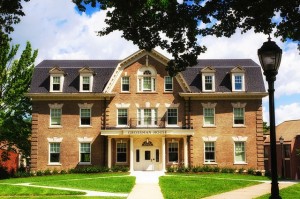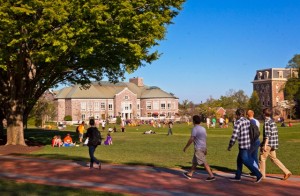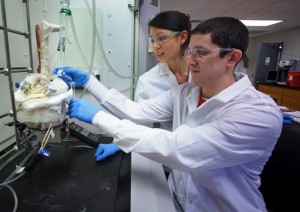At Lafayette, green is the new maroon. The only school in the Lehigh Valley that signed the Presidents Climate Commitment – a 2008 initiative that saw 450 colleges and universities nationwide pledge to reduce campus greenhouse-gas emissions – Lafayette has set a high bar for environmental sustainability.
“We’re committed to conserving natural resources, making good long-term environmental decisions, and providing pleasant and healthy places for students, faculty, and staff,” says Mary Wilford-Hunt, director of facilities planning and construction.
Capital projects

Grossman House earned a LEED-CI Gold designation.
Leadership in Energy and Environmental Design (LEED) Silver level design is targeted on all new construction and major renovation projects. Depending on how “green” a building is, it can achieve basic, silver, gold, or platinum certification. One of the greenest ways to develop, Wilford-Hunt says, is to repurpose existing structures rather than build new ones.
The Grossman House for Global Perspectives, a special residence for students interested in topics related to globalization, is a perfect example. Fully renovated in 2012 from a fraternity house originally built in 1915, it recently earned a LEED-CI Gold designation from the United States Green Building Council for its sustainable design, construction, and operation. Among its features are windows that reflect heat back to its source (reducing energy use to heat and cool the building), Forest Stewardship Council certified wood products, and a water retention cistern that captures rainwater that is used to flush fixtures.
Renovations at the former Club Mohican building on N. Third Street, including repair of the exterior masonry, terra cotta facade, windows, sash painting, brick repointing, and roof work, breathed new life into an existing structure while creating a more attractive entrance to the College.

Students walk along a pathway on the newly-renovated Quad.
The ambitious Quad renovation project, completed last year, transformed the campus center into a more attractive, quiet, and environmentally sustainable place. Roadways were removed, improving storm water runoff. To reduce local warming, also called the heat island effect, paved surfaces were replaced with lawn. Improved walkways are safer and encourage walking and biking rather than driving. Native plants, benches, and bike racks also were added.
Among the projects in progress is the Oechsle Center for Global Education, a three-story, state-of-the-art facility themed around interdisciplinary global studies that will house the international affairs and Africana studies programs and the Anthropology and Sociology Department. The center features regionally-sourced and environmentally-friendly materials. Daylighting, lighting controls, and LED lighting will reduce energy usage. A significant interior feature will be the “Global Wood Wall” made of reclaimed wood paneling.
Other sustainable campus highlights include: the green roof and solar array at Acopian Engineering Center, the LaFarm Community Garden & Working Farm at Metzgar Fields, and the solar array at Metzgar Fields, which received a construction grant from the Sustainable Energy Fund.
Environmental curriculum

Professor Lindsay Soh works in her lab with Christopher Verni ’15.
The College’s commitment to sustainability doesn’t end with its facilities. It has infused sustainability throughout the curriculum, most significantly with the 2012 launch of the environmental studies and environmental science programs. A three-year, $800,000 grant from the Andrew W. Mellon Foundation helped fund the new majors as well as nearly 40 student-faculty research projects focused on the environment.The College also created 12 environmental courses and enhanced the content of two others.
Professors often collaborate with students on high-level research pertaining to sustainability. For example, Christopher Verni ’15 (Medway, Mass.), a dual major in chemical engineering and Spanish, is working with Lindsay Soh, assistant professor of chemical and biomolecular engineering, on processing oils, such as those extracted from corn or algae, into sustainable biodiesel. Civil engineering major Emily Crossette ’15 (Glennfield, Pa.) earned a $50,000 Environmental Protection Agency fellowship to fund continued work on wastewater testing with Art Kney, associate professor and head of civil and environmental engineering.
Student interest in sustainability extends beyond campus as well. A project led by David Brandes, associate professor of civil and environmental engineering, to install a wetlands habitat at Sullivan Park in Easton helped it become Pennsylvania’s 2014 Green Park of the Year.

Courtney Landolfe ’14, Max Dixon ’16, and Corey McKenna ’16 at West End Roatan in Honduras
Over the winter break, four students traveled to Roatan Island, Honduras, with Wilford-Hunt and David Veshosky, associate professor of civil and environmental engineering,to study the feasibility of waste-to-energy power plants as an alternative to imported diesel fuel
Last summer, students in Technology Clinic created a “Veggie Van” that distributed free fruit and vegetables grown at LaFarm to residents throughout Easton’s West Ward neighborhood. The West Ward is considered a “food desert,” a neighborhood with limited access to fresh, healthy, and affordable food.
Campus sustainability organizations
Sustainability has quickly become a component of the College’s identity. In addition to academic research, there are many groups on campus that are working toward a greater understanding of sustainability and putting it into practice.
The Sustainability Committee comprised of students, faculty, and staff assists in coordinating Earth Month activities, helped streamline the College’s composting system, and evaluated the effectiveness of campus recycling policies. It also is working to establish ECOreps, individuals who will work with the College to promote sustainable living in the residence halls.
Other student-run organizations include Lafayette Environmental Awareness and Protection (LEAP); Engineers Without Borders, a multidisciplinary group dedicated to meeting the basic health needs of developing communities around the world; Society of Environmental Engineers and Scientists, which conducts research on current environmental science and engineering problems; and TREEhouse (The Real Environmental Experience House).




2 Comments
I love the topics, sustainability and neighboring cooperation.
In the laudable Lafayette spirit of cooperating with its neighboring community, students and faculty may be interested in joining with the Lehigh Valley chapter of Citizens’ Climate Lobby to work here and in Washington for a straightforward solution to stopping fossil fuel emissions by mid-century. Check out CitizensClimateLobby.org and email to lehighvalley@citizensclimatelobby.org
Comments are closed.